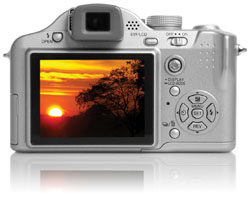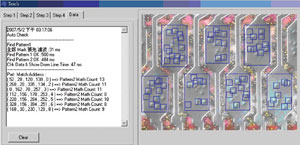The Demands of LCD Quality Control Push the Laws of Physics
Used for displays in all manner of electronic gadgets, LCD panels are a mainstay of everyday life. Dozens of manufacturers – mainly in China, Taiwan, Japan and South Korea – produce a seemingly endless stream of these liquid crystal attention-getters, and consumer demand for products that incorporate LCD screens just keeps growing. But while the manufacturing process has been standardized, with little if any room for improvement, a major roadblock has appeared: rapid, accurate inspection of LCDs during the manufacturing process.
Not very long ago, LCD systems were inspected on the manufacturing line by people – human eyes attempting to spot black, dead pixels on the fly in newly made displays. LCD producers, including Samsung, Sony, Panasonic, LG and their competitors, eventually moved to advanced machine vision systems to replace eyeballs but now are in a continual race to improve the speed and resolution of these systems.

From digital cameras to giant high-definition TV monitors, no matter what size they come in, LCDs have become commodity products that nevertheless demand high quality control measures.
“The state of the art is a moving target,” said Greg Hollows, director of machine vision solutions at Edmund Optics Inc. in Barrington, N.J. “The industry moves as fast as any I’ve ever seen – including semiconductors.”
LCD inspection systems face targets that are shrinking as well as growing. Currently, the individual pixels that comprise an LCD panel are 5 μm across – down from 10 to 15 μm a few years ago. That equates to millions of pixels, each of which must be tested under power several times during the manufacturing process. On the other hand, the arrays of pixels in television panels continue to grow to enormous sizes: 42-, 50- and 60-in. devices are becoming the norm, and larger still are fast approaching.
The mantra has become “early and often” – defects in any LCD product must be discovered as quickly as possible so as not to waste time and resources on bad products. In the worst case, there may be a problematic machine or process used in the steps leading to the first test that must be rooted out.
At Edmund Optics, Hollows and his team design specialized lenses for machine vision inspection systems. Their customers continuously seek to make the inspection process faster, but with higher resolution. Therein lies the problem: Smaller pixels demand lenses with smaller fields of view, which in turn puts an end to much hope for speed.
“Our customers want us to design, prototype, build and ship lenses in eight to 12 weeks, but that’s hard when you keep pushing the laws of physics,” Hollows said.
At camera maker Imperx Inc., president and CEO Petko Dinev agrees about what LCD manufacturers want: “The faster the better, the higher-res the better.” But where Edmund Optics sees mostly line-scan cameras being used, Dinev believes that cameras that cover broader regions of LCD products are the future.
“LCD inspection must be as precise as possible over a large area,” he said. “Area-scan cameras are best for high-speed glass-defect inspections.”
It takes numerous cameras in a system to test every pixel at high speed, whether the system uses line- or area-scan cameras. Dinev noted that a dozen 11-megapixel area-scan cameras are needed to look over a 4 × 8-ft LCD panel. He sees larger, faster cameras coming, but at a cost to users – and not just price. Cameras that work at 10 fps and 20 to 30 megapixels may come, he suggested, but the amount of data they produce will expand too much to be processable.
“Cameras have to be smarter,” Dinev said. “Small, incremental changes will help.”
Zero defects
Some industry wishful thinkers say that a “zero defect” policy is possible, which would leave inspection systems with nothing to do. With screens getting bigger, however, millions of pixels lined up in great rows would seem to be resistant to such a utopian vision. Manufacturing defect-free panels – even if possible – would be horrendously expensive, thus jacking up consumer prices and suppressing sales. Some LCD makers at the bottom end of the market already sell products, including televisions, with a relatively large number of dead pixels, just to keep prices down for one segment of the buying public.

New software algorithms are being developed to speed up LCD inspection without sacrificing manufacturing speed. Courtesy of Chern-Sheng Lin, Feng Chia University, Taiwan.
In fact, researchers at the corporate level as well as in academia – including places such as Korea Advanced Institute of Science and Technology in Daejon and Feng Chia University in Taichung, Taiwan – continue working to improve inspection techniques. According to Chern-Sheng Lin, a researcher in the automatic control engineering group at Feng Chia University, “zero defect” is an impossible dream. However, he continues to work on improving inspection techniques, such as developing algorithms for more precise alignment of LCD components during scans.
Next on the line
LCD manufacturers find themselves in a bit of a bind. Consumers want bigger and better, which means that faster and more exact inspection systems are required. Developing real-time inspection systems that can classify defects on the fly and pull bad panels out of the line as quickly as possible is the goal. Cameras, lenses and analytical software can move only so fast until the laws of physics start to get in the way.
“A lot of things will change [in the LCD industry] in five years, but not so much in six months,” said Imperx’s Dinev. “There will be more demand for different types of displays.”
New demand for flexible, low-power display types such as organic LEDs will challenge LCD makers even more in the next few years. That push, which will come for a market desire for more elegant wall-hanging televisions and slim, easy-to-adapt e-readers, will have their own quality control issues. Machine vision pioneers who helped shape LCD production will no doubt translate their expertise to those display needs when the time comes.